China Sea
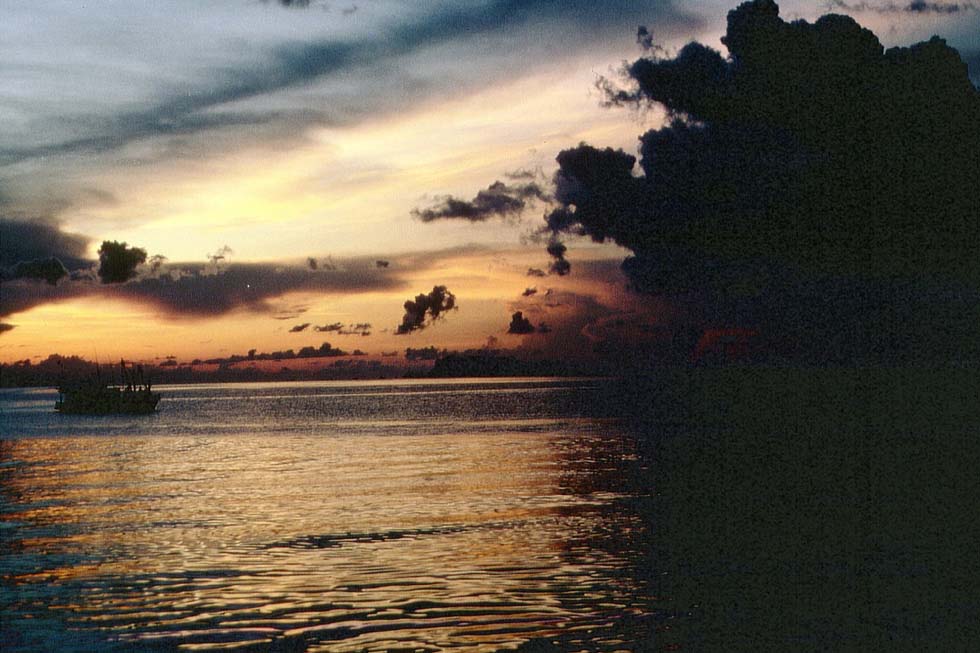
Coast of Thailand (Dr. Friederike Soelch)
China is the dominating country. After the Ming dynasty had replaced the Mongolian rule, Zheng He, the Emperor's admiral, sailed in 1405 with a fleet hitherto unknown in size through the Strait of Malacca and founded commercial establishments at the coast of India, Arabia and Somalia. The ships were wooden junks and recently archeologists have proven that they really had a length up to 120 metres or more, with 9 masts. The succeeding Qing dynasty abandoned naval power, thus unwittingly opening the ocean to the Europeans. With the Opium War of 1838, China's humiliation was demonstrated in a brutal way. In 1842 the British conquered Shanghai. China became harassed by colonialism, slavery, corruption and starvation, in the 1930s by the Japanese aggression and until 1949 by civil war.
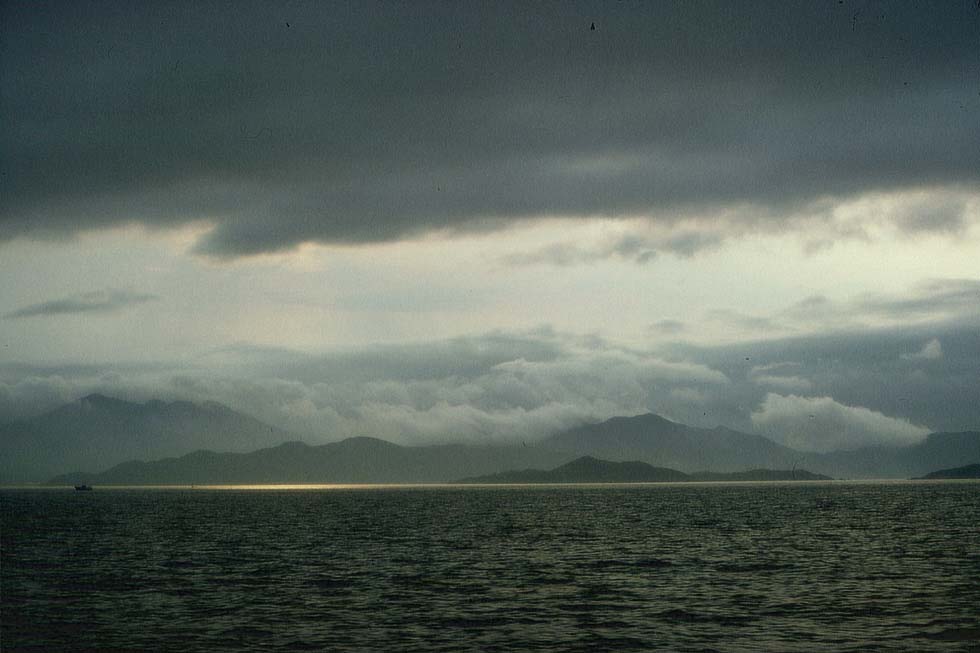
China Sea near Macau (WS)
British to the China Sea
The "Lady Mary Wood" was the first steamer of the P&O, which opened in 1845 a service from Point de Galle, Ceylon, to Singapore and Hong Kong (according to R. Kirk), in 1847 extended to Bombay - Hong Kong. The first P&O steamer arrived at Shanghai in 1846 (according to D. Divine). In 1848 the P&O steamer "Canton" opened the connection Hong Kong - Macau - Canton and in 1852 the P&O got a contract for China mail services. About the difficulties E.A. Ewart wrote: "There was first that minor but worrying 'war' with the sailing-ship and opium interests in the Far East which had forced the withdrawal of the "Lady Mary Wood" from the Hong Kong - Shanghai service. Also the British India Line opened connections to China early in the 19th century. The timetable of the 1920s showed a route Calcutta - Singapore - Kobe, Japan. Bangkok was served by the East Asiatic Co. of Denmark and by the branch lines of other companies. The Gulf of Thailand was crossed by local steamers. Much later the Eastern & Australian SS Co. together with P&O Orient Lines of Australia acquired the "Parthia" of Cunard (13,619gt, built in 1948 renamed "Aramac") for Australia - Hong Kong - Manila - Japan services. Competitor was the Dominion Navigation Co with their Australia - Japan - Guam - Rabaul route. Still in the '60s they were listed with the "Francis Drake" (1947/7,176gt) and sister "George Auson".
An enterprise with an old tradition is John Swire & Sons, founded in Liverpool in 1812. They established a subsidiary in China in 1867. From 1872 their China Steam Navigation Co. built up shipping services on the Yangtze river and later also to Java, Australia, New Zealand, the Philippines and Manchuria. Still in 1969 they acquired the "Kuala Lumpur" (12,598gt), the former "Dilwara" of British India Lines, for pilgrims' voyages and for cruises. Their motor-ships "Changsha" and "Taiyuan" of 1949 were used for an Australia - Japan service and smaller vessels served the Australia - Hong Kong route (in the 1970s they disappeared from the timetable and the Swire group got much more famous with their airline Cathay Pacific). The ABC Shipping Guide showed at the end of the 1970s still the Golden Line Penang - Singapore - Hong Kong - Hoikow - Swatow with the "Kim Ann".
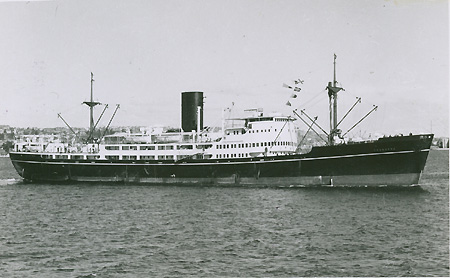 "Changsha" of China SN Co, Sydney 1949 (old card, coll. WS)
"Changsha" of China SN Co, Sydney 1949 (old card, coll. WS)
Other Services
France took possession of Saigon in 1859-61. Messageries Maritimes introduced services Hong Kong - Haiphong and Hong Kong - Saigon in 1877, a connecting line Singapore - Saigon in 1880 and Saigon - Haiphong around the same time. Almost a century later, war devastated Vietnam and neighboring Cambodia. Weapons from the Soviet Union were not delivered by rail through China, but by the seaway to the Vietnamese harbour Haiphong. After the American retreat, coastal shipping re-opened the first passenger service between Saigon (Ho Chi Minh Ville) and the North in 1975, before the railway Saigon - Ha Noi was repaired. Then the shipping route disappeared from Cook's timetable. Better known became the "Vietnamese boat-people", refugees who had arrived during war-time at Hong Kong or elsewhere, if they survived.
From 1880 the Nederlandsch-Indische Stoomboot Maatschappij operated a steamer line Java - China. The Koninklijke Java-China-Pakeetvaart Lijnen N.V., then known also as Royal Interocean Lines, provided between the wars services even from Asia to South America. For their Australia - Japan route they acquired in 1950/51 new motor ships and in 1971 the "Randfontein" (13,568gt) of the NV Vereenigde Nederland S.M., then renamed "Niew Holland". Between the wars also the Holland-East Asia Line undertook voyages to Dalian, at that time known as Dairen.
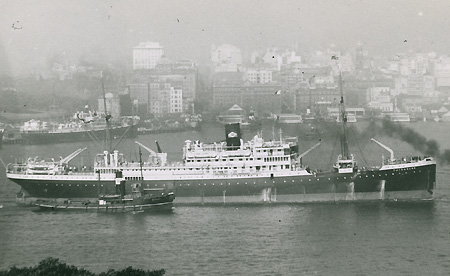 "Tjisadane" of Koninklijke Java-China-Pakeetvaart (old card, coll. WS)
"Tjisadane" of Koninklijke Java-China-Pakeetvaart (old card, coll. WS)
Germany got its Chinese outpost Tsingtau, now Qingdao, in 1898. The Norddeutscher Lloyd (NDL) strengthened its position in 1904 with an "Austral- Japan-Linie", calling at Rabaul, Bismarck-Archipel, a hub for other island services. In 1912 also Manila became a port-of-call. In China, the German Woldemar Nissen founded in 1887 a coastal shipping company, in 1901 taken over by Hapag. Around the beginning of the 20th century, M. Jebsen introduced a line from Shanghai to ports of northern China and Melchers & Co. appeared on the Yangtze river. With WWI the German services were interrupted. The DR timetable of 1925 listed joint services by Deutsch-Australische Dampfschiffsgesellschaft, in connection with S.M. Nederland and Rotterdam Lloyd from Hamburg to Makassar, by Hapag in connection with NDL, Holt & Co. and Ellermann & Bucknall to Yokohama, by Hapag with NDL to Dalian, by Rickmers-Linie to Dalian, "possibly Vladivostok", and by Hugo Stinnes-Linien to Yokohama. Before the NDL re-opened its Austral-China line in 1934, an agreement with Burns, Philp & Co. was concluded. They took over that service and acquired the NDL two-funnel motor-ships "Neptun" (ex "Rio Panuco") and "Merkur" (ex "Rio Bravo").
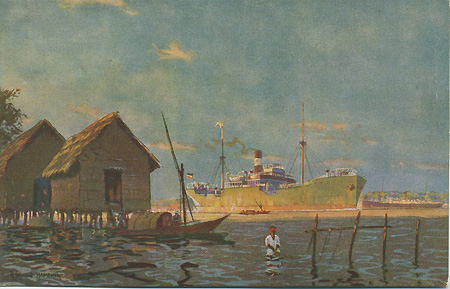 A steamer of Rickmers-Linie (pre-war card, coll. WS)
A steamer of Rickmers-Linie (pre-war card, coll. WS)
Asian Ferries
"I left Bangkok on a shabby little boat of four or five hundred tons. The dingy saloon, which served also as dining-room, had two narrow tables down its length with swivel-chairs on both sides of them. The cabins were in the bowels of the ship and they were extremely dirty. Cockroaches walked about... It was but a run of 36 hours from Bangkok to Kep, on the Cambodian coast, to which I was bound so that I could get to Pnom-Penh and so to Angkor".
W. Somerset Maugham
On a Chinese Screen
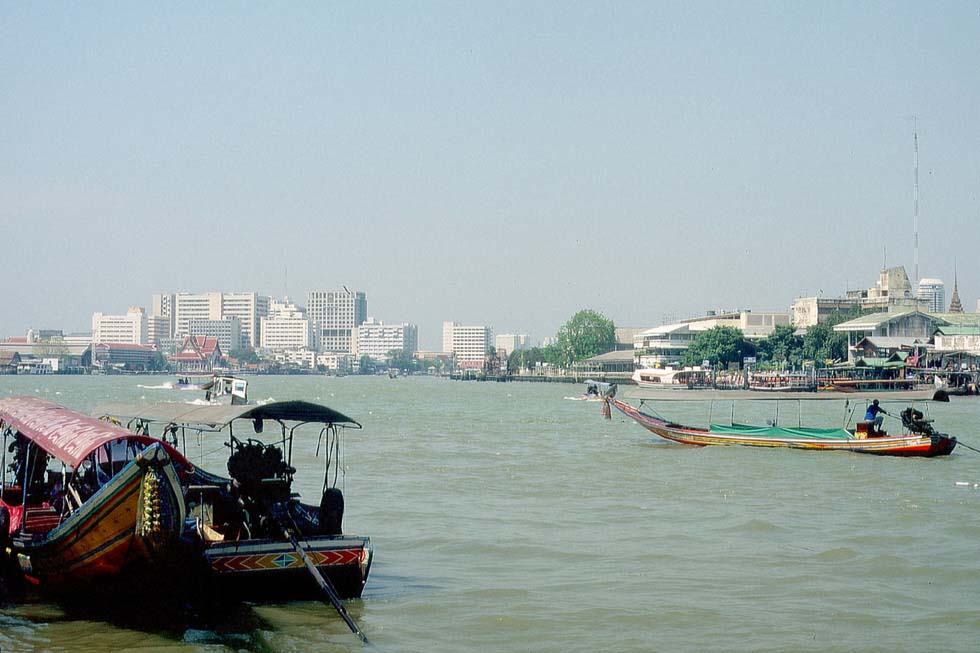
Bangkok (WS)
Towards the end of the 1970s the ABC Shipping Guide showed a twice-monthly sailing by the Thai Maritime Navigation Co. to the Gulf of Thailand with the "Bhanurangsi". The authorities prevented acquisition of Danish ferries in 1997 by unknown reasons. Thailand had exclusively local ferries at Bangkok, at Phuket Island in the west by Songserm Borikam and other providers and around islands in the east. Authorities allowed only the purchase of the Norwegian "Kong Olav" of Hurtigruten by the company Andaman Club. Nevertheless the timetable of 2008 listed Lomprayah High Speed Ferries with a route Bangkok - Ko Samui Island. A way from Cambodia to Bangkok, described by Cook's timetable, is to take the boat from Sihanoukville via Koh Sdach island to Koh Kong on the coast close to the Thai border and from there taxi and bus.
In Vietnam, local boats are connecting Saigon with the coast. Fast ferries and hydrofoils are operating between Hai Phong and Cat Ba and other picturesque islands close to China.
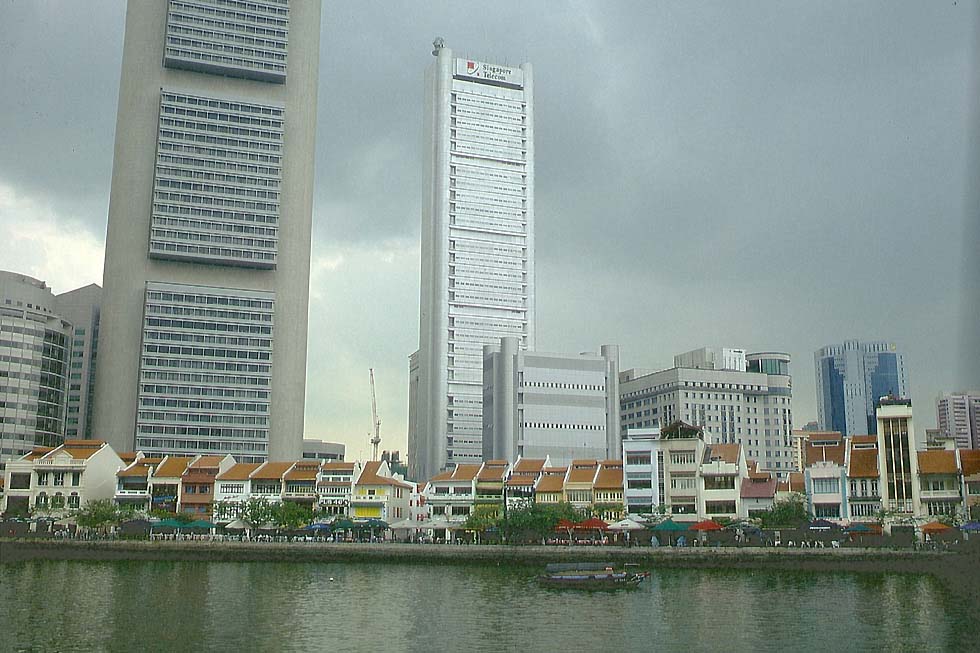
Singapore, 2001 (WS)
At Singapore, the traditional provider of local and coastal services was the Straits Steamship Co. Among their white steamers, the "Kedah" (2,499gt) of 1927 was renowned for her Penang and Balawan services. The company continued its dominance as Straits Shipping. The short route from Tawau on Sabah (North Borneo) to Nunukan on Kalimantan (in the Indonesian east of Borneo) was maintained by the Nunukan Shipping Agency. During the age of car ferries, Straits Shipping continued to link Singapore with Sabah and Brunei, but then the services disappeared from the timetable. Singapore - Kuantan - Kota Kinabalu was the route of Feri Malaysia with the "Cruise Muhiba" to connect the Malaysian part of Borneo. Shipping along that coast was maintained by Express Bahagia.
What remained, are various Singapore local services and routes to nearby islands belonging to Indonesia. ShipPax listed more than a dozen operators on those "international" routes. Cook's Overseas Timetable mentioned e.g. in the first decade of the new century Auto Balam Ferries, Bintan Resort Ferries, Dino Shipping and Indo Falcon on services to Tanjung Pinang on the island Pulau Bintan, Dino Shipping and Indo Falcon also to Batam, and Ferrylinks to Tanjung Belungkor.
Remarkable was the registration of the 1997-built car-carrying 82m Austal catamaran "Super Star Express" for Star Cruises. Singapore River and harbour cruises with little boats are another matter.
There was always the Langkawi Ferry Service, listed by Cook's also with a route from Penang to Medan, Sumatra. ShipPax registered e.g. in 2006 however Lada Langkawi only with passenger hi-speed services between Langkawi and Kuala Perlis and Kuala Kedah in Malaysia. Penang Island continued to be connected by car ferries, though a long bridge to the Malaysian mainland had been built.
Hong Kong and Macau Ferries
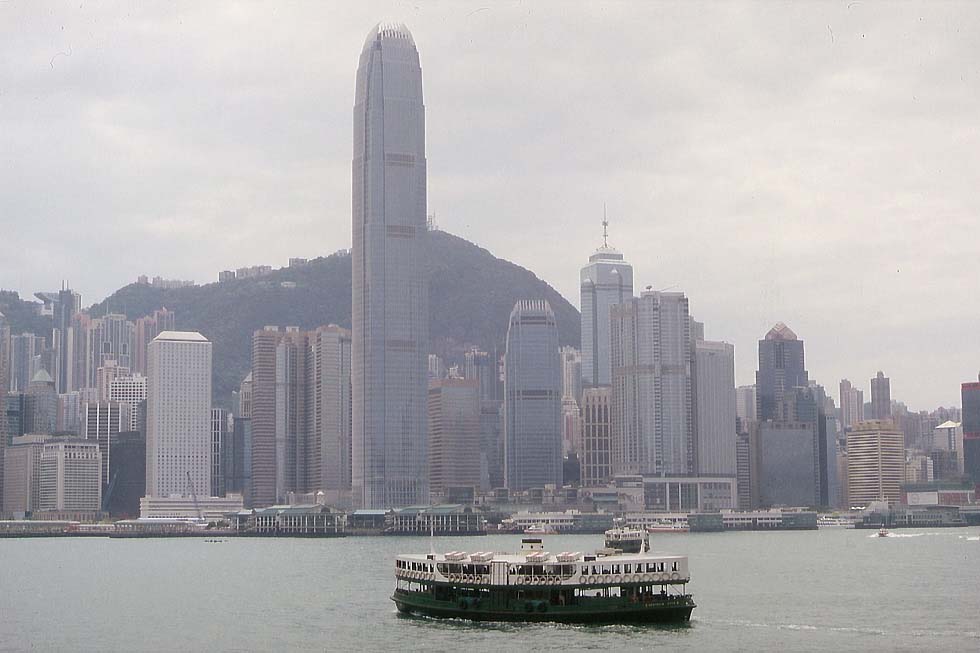
Hong Kong and a Star Ferry, 2011 (WS)
For the British East India Company, Canton (now Guangzhou) had been an important trade centre, situated at the mouth of the Pearl River. Hong Kong on the sea shore however has achieved more importance after it had become a British colony in 1843.
Already since 1898 the passenger boats of Star Ferry are connecting the mainland quarter Kowloon with the Hong Kong business centre on Victoria Island. Since 1911 Kowloon is connected with Guangzhou by rail, from 1952 however interrupted for some time due to the Cold War. In the 1970s also "vehicle passenger ferries, watertaxis and hoverferries" of the Hong Kong & Yaumati Ferry Co. were described serving several routes, including Guangzhou. The nearby Portuguese colony Macao was connected by passenger boats of Shun Tak Shipping, passenger hydrofoils of the Hong Kong & Macao Hydrofoil Co. and also faster 'jetfoils' of the Far East Hydrofoil Co. In 1997 the British concession for Hong Kong ended, it became a part of China like in 1999 also Macau, both with an autonomy status for 50 years. In Hong Kong, Star Ferry with the green boats preserved its tradition. Hong Kong & Yaumati Ferries maintained vehicular routes. Mainly TurboJet of Shun Tak Shipping, First Ferry or New World First Ferry Services (Macau) Ltd and CotaiJet are remarkable among the companies connecting Macau. CotaiJet belongs to Cotai Strip, a casino and tourism enterprise at Macau, funded by Las Vegas Sands. Also Guangdong, Chu Kong Shipping, Shenzhen Xunlong, Shenzhen Pingxing, Panyu Nansha of Guangzhou and other passenger hi-speeds are busy in the mouth of the Pearl River.
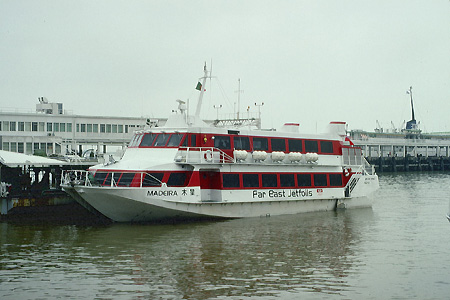
Boeing Jetfoil "Madeira" of Far East Jetfoils, after arrival from Hong Kong at Macau, 1988 (WS)
|
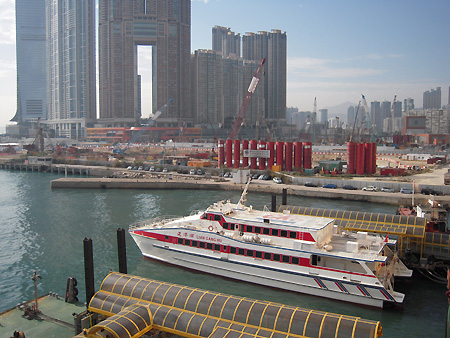
"Lian Gang Hu" of Chu Kong Shipping, China Ferry Terminal, Kowloon, 2011 (WS)
|
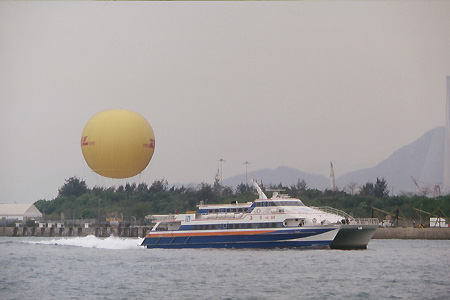
"Hai Bin" of Chu Kong, ex "Shun De" of Shun Gang (?), China Ferry Terminal 2011 (WS)
|
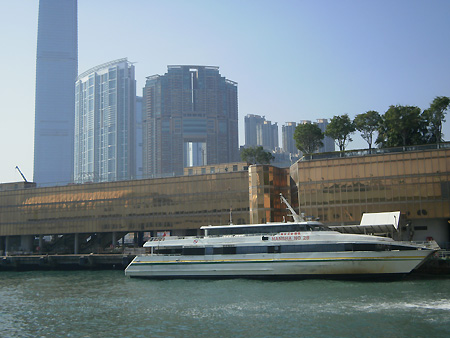
"Nansha No.28" of Panyu Nansha Shipping, China Ferry Terminal, 2011 (WS)
|
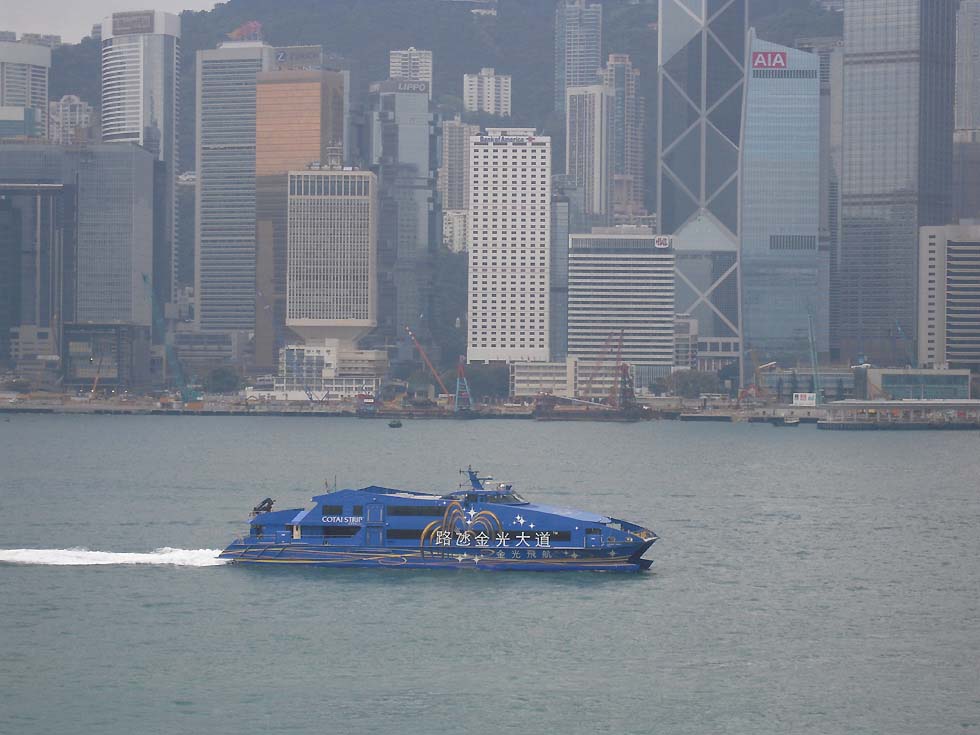
A CotaiJet boat of Cotai Strip, Hong Kong 2011 (WS)
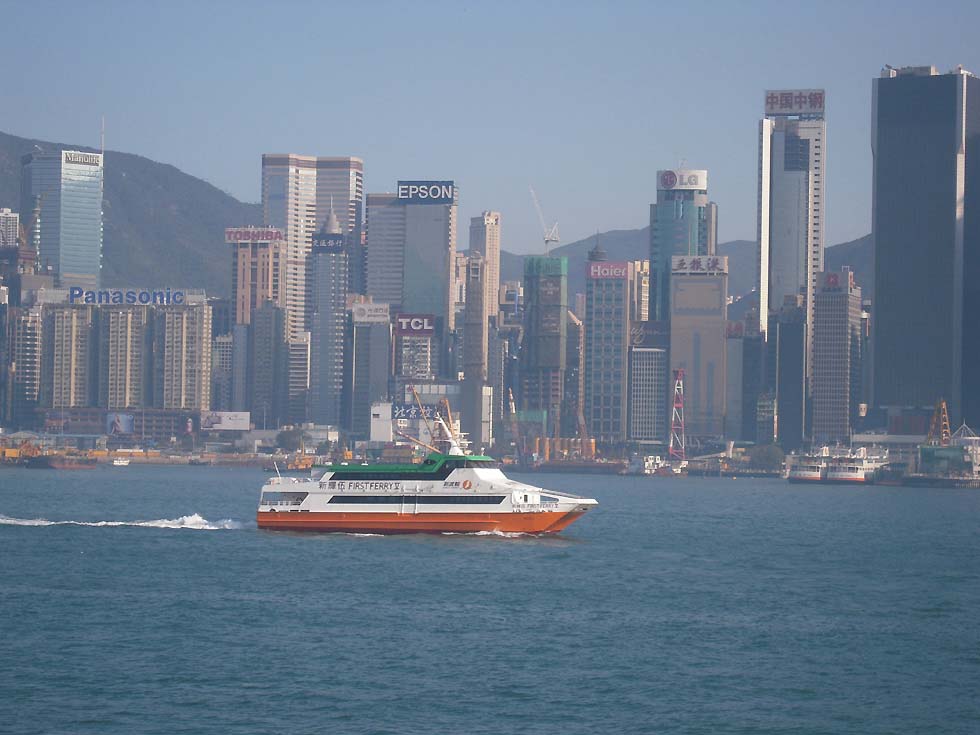
"First Ferry V" of First Ferry, Hong Kong 2011 (WS)
China Domestic
With the victory of Mao Zedong over Chiang Kai-shek in 1949, China was united, submitted to dictatorship, the Soviet Union being its partner until 1960. During that time, poverty and exploitation of work force was combated, but also religion and culture, and the communist economy stagnated. Not before the late 70s, mainly under Deng Xiaoping, commerce was liberated. China's rise to a superpower began, reviving also its religious and cultural values.
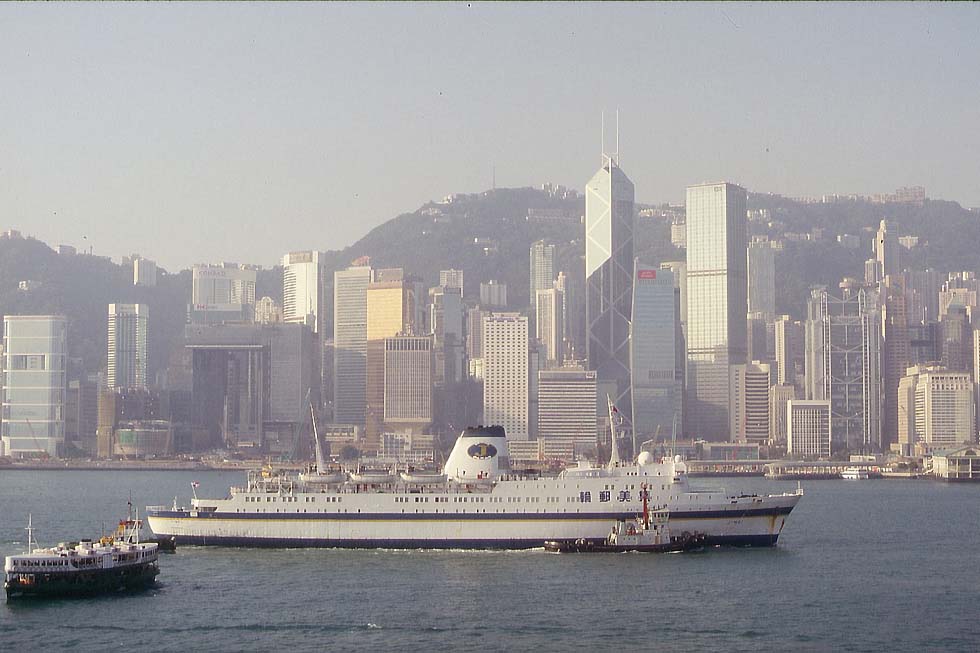
"Jimei", the former "Prinsesse Ragnhild" of 1966, Hong Kong 2011 (WS)
During the Maoist epoch, shipping was state-owned and strictly regulated. The service Hong Kong - Shanghai was stopped around 1952, when the Cold War escalated. According to the informative Lonely Planet travel guide by A. Samagalsky/ M. Buckley, it was re-opened in 1980, calling in Shanghai at the International Passenger Ferry Terminal on the Huangpu River. Historian Arnold Kludas reported the purchase of the steamer "Baudouinville" (13,922gt) of the Cie. Maritime Belge, later P&O, by the Chinese government, from 1984 employed by the Shanghai Hai Xing Shipping Co. on the Shanghai - Hong Kong route, named "Kengshin", then "Shanghai". The former "Randfontein" (1958/13,694gt) of Nederland, then "Nieuw Holland" of Koninglijke Java-China Paketvaart, later as "Yu Hua" used on the route China - Tanzania, became in 1981 the "Hai Xing" of the Shanghai Hai Xing Shipping Co. on the Shanghai - Hong Kong route. Samagalsky/ Buckley described her as the best ship, like the "Shanghai" equipped with pool, dance floor, cabins and a 20-berth sleeping-hall, mentioning the obviously best-known name China Merchants Steam Navigation Co. In 1984 the former "Mariposa" (9,217gt) of Matson Line was introduced by China Ocean Shipping as the motor ship "Jin Jiang" on a similar service.
The sub-tropical island of Hainan in the south was a place of strategic importance mainly when in 1979 China started an attack on Vietnam, obviously fearing erection of a Soviet influence sphere. Samagalsky/ Buckley reported the restriction of individual tours there from 1982. The island harbour Haikou, connected with the mainland by ferry, was the port-of-departure for a coastal service to Guangzhou. For newer information see also chapter Train Ferries.
The travel guide of the 80s listed also a coastal service from Zhanjiang in the south to Hong Kong, connections from Hong Kong to Xiamen (the former Amoy), from Mawei (the harbour of Fuzhou) to Shanghai, services Shanghai - Qingdao and other routes. Departure at Shanghai was on several wharfs on the Huangpu River. For the service Hong Kong - Xiamen the Fujian Province Shipping was listed. The "Ji Mei" and "Gulangyn" were registered for Hong Kong - Xiamen and the "Dinghu" for Hong Kong - Shantou services.
In the age of container shipping, Chinese state-owned shipping became famous under the label COSCO, expanding to one of the biggest shipping firms in the world. For their various subsidiaries they acquired a multitude of vessels, initially bought second-hand mainly from Scandinavia and Germany. As far as the last decade of the 20th century is concerned, Ortel/ Foerster reported COSCO daughter Xiamen Shipping employing the former 5,712-ton "Armorique" of Brittany Ferries as "Nin Nan" and the "Ji Mei", the former 8,500-ton "Prinsesse Ragnhild". This 8,500-ton car ferry was built in 1966 at Howaldtswerke for Jahre Line Oslo - Kiel. COSCO subsidiary Guangzhou Maritime introduced the "Hong Ju" (ex "Epirus" of 1974) and the "Tian Lu" (ex "Georgios"). Shantou Shipping used the "Jin Hu" (ex "Drottningen" of 1968). The "Xiang Xue Lan" (1996/16,071gt), one of the newbuilds from Germany, was reported being employed by China National Transport between Shanghai and Hong Kong, later transferred to C&K. Those newer ships replaced older passenger-cargo vessels, e.g. the "Jin Jiang", "Shanghai" and "Hai Xing" of the 1950s, which went to the scrapyard. James Sherwood's "Orient Express" survived the turn of the century as "Wasa Queen" of Cruise Ferries Hong Kong - Xiamen. Shanghai Hai Xing had chartered out the passenger-cargo vessel "Zi Ding Xiang" (1996/12,307gt) as "Arafura Lily", then employing her between Hong Kong and Fuzhou (for her confusing career see chapter Yellow Sea). Concerning long passenger routes, Cook's timetable listed e.g. in 2008 the services between Hong Kong and Haikou on Hainan Island and Hong Kong - Shanghai by China Merchants Shipping. Other services mentioned were Hong Kong - Xiamen by Yick Fung Shipping and Hong Kong - Shantou by Hong Kong & Yaumali Ferry and Chu Kong Shipping. Among roughly a dozen Chinese ferry companies during the 90s, listed by Ortel/ Foerster, were also rather unknown ones, such as Hainan Libao with the 3,985-ton "Naxos" of 1975. For the services to Dalian in the north and to Korea see the chapter Yellow Sea.
Astonishing is the number of Austal catamarans delivered to China, not only for the services around Hong Kong. Shanghai was connected with nearby Ningbo by hi-speed passenger services of Ningbo Huagang and Shanghai Free Flying and with Nantong by Nantong Hi-Speed. Generally a survey of all the hi-speed services cannot be given, as there is a steady change and most operations are confined to relatively short routes.
China - Japan Ferries
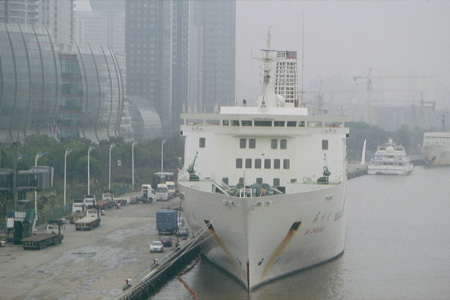 "Su Zhou Hao" of Shanghai Ferry Co, bound for Japan, at Shanghai terminal in 2011 (WS)
"Su Zhou Hao" of Shanghai Ferry Co, bound for Japan, at Shanghai terminal in 2011 (WS)
At present roughly half a dozen ferry services are crossing the sea on the way from China to Japan. The longest routes are Tianjin - Kobe by China Express Line and Qingdao - Shimonoseki by Orient Ferry, initially with the first "Utopia". Qingdao is now one of world's largest container harbours. Shanghai, the mega city with 13 to 20 million inhabitants, became connected with Shimonoseki by Orient Ferry, employing the "Utopia 2", with Kobe by Shanghai Hai Xing Shipping, using the "Yu Jin Xiang" (then transferred to Korea services) and by the China-Japan International Ferry (CHINJIF). It got a connection with Osaka also by the Shanghai Ferry Co., their "Su Zhou Hao" being the former "Lu Xun" (14,410gt), introduced in 1992. Those ferries are berthing at the International Passenger Ferry Terminal on the Huangpu, not far away from Shanghai's 'Bund', the avenue famous since the colonial epoch. China National Transport has been reported employing the "Zi Yu Lan" (16,071gt), one of the two passenger-cargo vessels delivered in 1996 from Germany, on a Shanghai - Kobe service, later transferred to C-K. Cook's timetable listed e.g. in 2008, apart from the Shanghai Ferry Co., once-monthly passenger services from Shanghai to Yokohama, Kobe or Osaka by Nittchu Kosukay Ferry and a service between Dalian and Kokura, opposite Shimonoseki, by the Dalian Passenger Shipping Co.
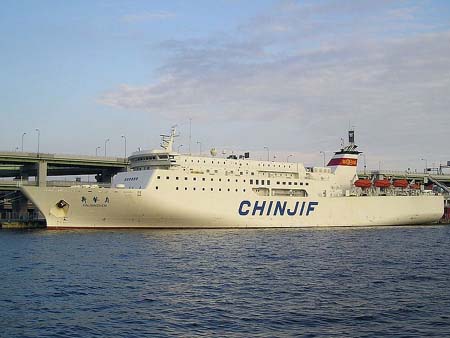 "Xinjianzhen" of China-Japan International Ferry at Kobe (via Wikimedia)
"Xinjianzhen" of China-Japan International Ferry at Kobe (via Wikimedia)
Taiwan
Taiwan had been annexed by the Japanese in 1895, named Formosa (for shipping connections Japan - Formosa see chapter Japan Sea). With Japan's defeat and retreat in 1945, a General Governor of Chiang Kai-shek's forces took over. After Mao's victory in 1949, Chiang Kai-shek with the remains of his army (and China's gold treasure) took refuge on Taiwan. Since that time the Strait of Taiwan was a place of strategic importance and political tensions. Every shipping service between China and Taiwan was interrupted.
Passengers traveling from Japan to Taiwan had to change ferry at Okinawa Island, home to America's main military base in the region. In the 70s they could take between Osaka and Naha on Okinawa the car ferry "Hiryu" of Ryukyu Kaiun Kaisha and board there the "Gyokuryu" of Arimura Sangyo K.K. for Keelung (Chilung), the second-important harbour of Taiwan. In 1995 the "Cruise Ferry Hiryu" (16,494gt) of Arimura was introduced on a Nagoya - Keelung - Kaohsiung route. In the first decade of the 21st century, Cook's Overseas Timetable listed in 2008 services from Japanese ports to Naha by Ryuku Kaiun Kisen, Kansai Kisen, Marix Line and Naha - Keelung by Arimura Sangyo K.K. Later however, www.taiwonderful.net informed about Arimura Sangyo: "It seems the Taiwan-Okinawa service has been suspended as of June 2008 ...".
Keelung is connected with the prospering capital Taipei, 66 km distant, by the old Cape gauge railway, electrified. Already in the 1970s the ABC Shipping Guide listed a coastal drive on - drive off car ferry service between Keelung and Hualian on the east coast by the Taiwan Car Ferry Co. ShipPax mentioned e.g. in 2005 a service from Keelung to Nankan by Taiwan-Matsu Express with the small car ferry "Tai Ma". Matsu Lietao is a Taiwanese island group close to the coast of mainland China.
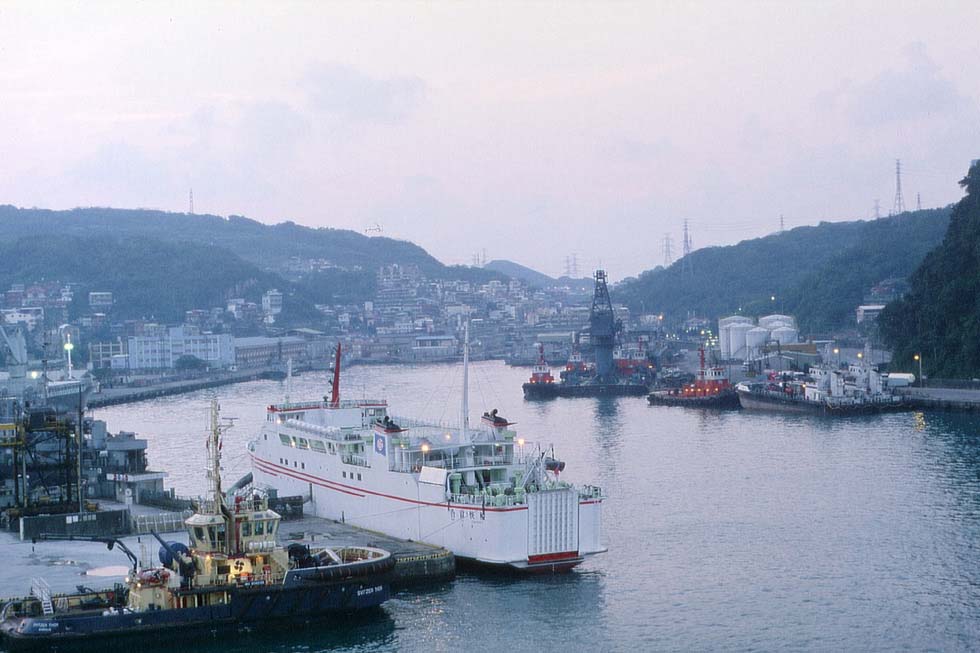
"Ho Fu Express", Keelung 2011 (WS)
The port in the south of Taiwan is Kaohsiung. Being the most important harbour of the country, it got in addition to the existing Cape gauge railway a standard-gauge high-speed rail link with Taipeh. Already in the 1970s, a passenger service from Kaohsiung to Makung on the Penghu or Pescadores Islands in the Taiwan Strait was listed, employing the "Taipeng", then replaced by a car ferry. Situated even closer to China is the island of Chinmen, shelled during the Cold War. Later it became connected with the mainland by a passenger boat, described by ShipPax as the "Marco Polo" of 2004 under Chinese flag on a route Xiamen - Kinmen.
For decades there had been no direct link between Taiwan and the mainland of China, neither by ship nor by plane. "Holders of passports issued by the Peoples Republic of China are prohibited at all times" from entering Taiwan, has warned the Cook timetable. About an initiative of Hong Kong's mighty Swire Group with the car ferry "Kong Olav V" of Denmark, Bruce Peter wrote in 'Baltic Ferries': " (The Swire Group) bought her from DFDS to link Hong Kong with Keelung in Taiwan." In 1972 however the ship became the "Baronessan" of Alandslinjen/ Birka. Nevertheless in the late '80s a service of the Macmosa Company was inaugurated between Kaohsiung and the mainland, not China proper however, but Macao. The ship was the "Macmosa", during eighteen years employed between Liverpool and Belfast.
The weekly Die Zeit (1stFeb.1991) published the following travel report by Oliver Toerner: "In the afternoon we embarked in the harbour of Taiwan. Somewhere in the tangle of docks, behind heaps of scrap, our ship lay hidden, easy to overlook, almost neat, surprising for everybody who knows the dimensions of ferry boats in Europe... Certificates here, documents there - we are amidst the crowd ... finally on board, our passports have been controlled innumerable times." There were veterans of Chiang Kai-shek's army on board, who have not seen their home, their families in China for decades. The description continues: "Most passengers go to their cabins after dinner. The casino remains closed... Next morning we enter the restaurant early and are the last. The stewards with their black jackets are handling already the vacuum-cleaner when we consume the noodle soup... In the afternoon the first islands, lead grey, are glimmering on the horizon. Some junks are passing by, downgraded to motor boats. A thick haze in the distance appears as the first sign of big cities. Hong Kong must be somewhere on starboard...".
A few years after, in 1994, the service was stopped. In 2005 China threatened Taiwan by placing missiles, whereupon some Japanese politicians claimed the Taiwan Strait being essential for oil shipment from Mideast, but that was considered merely an excuse for intervention since the sea lane east of Taiwan is shorter.
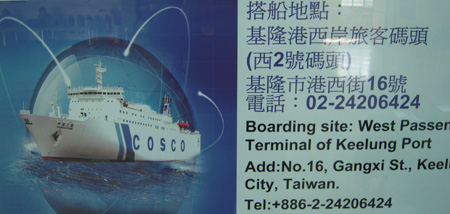 "Cosco Star" advertisement, Keelung 2011 (WS)
"Cosco Star" advertisement, Keelung 2011 (WS)
In 2009 some report announced opening a route from China to Taiwan with the 26,463-ton ro-pax "New Golden Bridge" of 1990 (obviously the "New Golden Bridge II"?). Owner of the various "Golden Bridge" ships is Weidong Ferry, but its home page showed (e.g. in 2011) exclusively Korea - China services. COSCO Xiamen started in 2010 a passenger service between China and Taiwan with the car ferry "Cosco Star" (1993/26,847gt), described (by 'Die grossen Passagier-Schiffe der Welt') as the former "Sun Flower Mito" of Japan, then "Panstar Sunny" of Korea. Xiamen - Taichung obviously was intended, but an advertisement of 2011 showed the West Passenger Terminal of Keelung as destination and reportedly Kaohsiung became evaluated. With tightening relations between China and Taiwan, possibly more services crossing the Taiwan Strait can be expected.
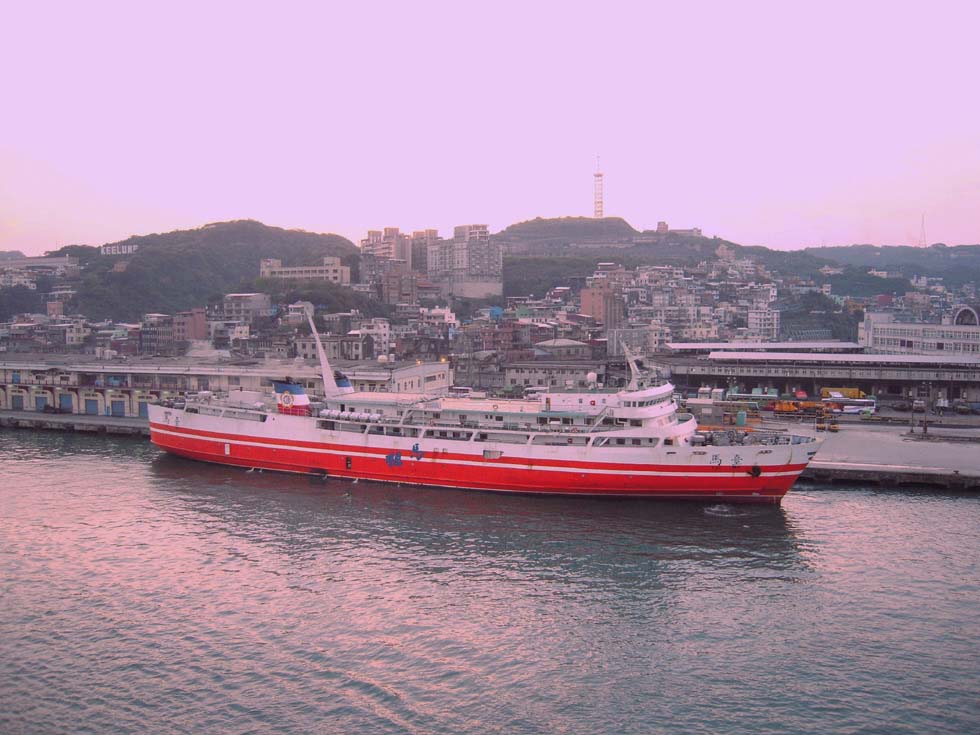
Sunset at Keelung, 2011 (WS)
|